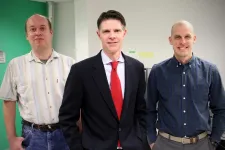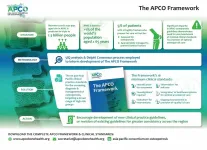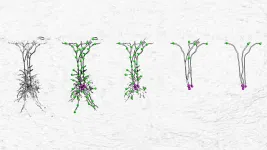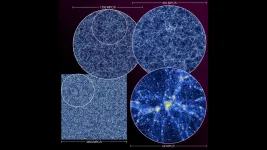VCU technology could upend DNA sequencing for diagnosing certain DNA mutations
2021-01-27
(Press-News.org) Doctors are increasingly using genetic signatures to diagnose diseases and determine the best course of care, but using DNA sequencing and other techniques to detect genomic rearrangements remains costly or limited in capabilities. However, an innovative breakthrough developed by researchers at Virginia Commonwealth University Massey Cancer Center and the VCU Department of Physics promises to diagnose DNA rearrangement mutations at a fraction of the cost with improved accuracy.
Led by VCU physicist Jason Reed, Ph.D., the team developed a technique that combines a process called digital polymerase chain reaction (dPCR) with high-speed atomic force microscopy (HSAFM) to create an image with such nanoscale resolution that users can measure differences in the lengths of genes in a DNA sequence. These variations in gene length, known as polymorphisms, can be key to accurately diagnosing many forms of cancer and neurological diseases.
A study detailing the method was recently published in the journal ACS Nano, and the research team reported their results at the annual meetings for the Association of Molecular Pathology and the American Society of Hematology. Previous research detailing the HSAFM technology was described by VCU Massey Cancer Center in 2017.
"The technology needed to detect DNA sequence rearrangements is expensive and limited in availability, yet medicine increasingly relies on the information it provides to accurately diagnose and treat cancers and many other diseases," says Jason Reed, Ph.D., member of the Cancer Biology research program at VCU Massey Cancer Center and associate professor in the Department of Physics at the VCU College of Humanities and Sciences. "We've developed a system that combines a routine laboratory process with an inexpensive yet powerful atomic microscope that provides many benefits over standard DNA sequencing for this application, at a fraction of the cost."
dPCR uses the DNA polymerase enzyme to exponentially clone samples of DNA or RNA for further experimentation or analysis. The sample is then placed on an atomically flat plate for inspection using HSAFM, which drags an extremely sharp microscopic stylus similar to the needle on a record player across the sample to create precise measurements at a molecular level. The technique was adapted by Reed's team to use optical lasers, like those in a DVD player, to process samples at a rate thousands of times faster than typical atomic force microscopy. The researchers then developed computer code to trace the length of each DNA molecule.
The team claims that each dPCR reaction costs less than $1 to scan using their technique.
To demonstrate the clinical utility of the process, Reed partnered with Amir Toor, M.D., hematologist-oncologist and member of the Developmental Therapeutics research program at Massey, and Alden Chesney, M.D., associate professor of pathology in the Department of Pathology at the VCU School of Medicine. Together, they compared Reed's technique to the current standard test to diagnose DNA length polymorphisms in the FLT3 gene in patients with acute myeloid leukemia. Patients with these mutations typically have a more aggressive disease and poor prognosis when compared to patients without the mutation.
Reed's technique accurately identified FLT3 gene mutations in all samples and matched the results of the current gold standard test (LeukoStrat® CDx FLT3 Mutation Assay) in measuring the lengths of the gene segments. However, unlike the current test, Reed's analysis also reports the variant allele fraction (VAF). The VAF can show whether the mutation is inherited and allows the detection of mutations that could potentially be missed by the current test.
"We chose to focus on FLT3 mutations because they are difficult to diagnosis, and the standard assay is limited in capability," says Reed. "We plan to continue developing and testing this technology in other diseases involving DNA structural mutations. We hope it can be a powerful and cost-effective tool for doctors around the world treating cancer and other devastating diseases driven by DNA mutations."
INFORMATION:
In addition to Toor and Chesney, Reed collaborated on his research with Sean Koebley, Ph.D., Andrey Mikheikin, Ph.D., Kevin Leslie, Ph.D., Daniel Guest, Wendy McConnell-Wells, Joshua Lehman, and Loren Picco, Ph.D., all from the VCU Department of Physics; and Taha Al Juhaishi, M.D., Xiaojie Zhang, M.D., and Catherine Roberts, Ph.D., all from the Cellular Immunotherapies and Transplant Program at VCU Massey Cancer Center and the Department of Internal Medicine at VCU School of Medicine.
Funding for the research was provided by National Institutes of Health grants R01GM094388 and NIH K12GM093857, grants from Virginia's Commonwealth Health Research Board (236-08-19) and, in part, by VCU Massey Cancer Center's NCI Cancer Center Support Grant P30 CA016059.
[Attachments] See images for this press release:

ELSE PRESS RELEASES FROM THIS DATE:
2021-01-27
Historically redlined neighborhoods are more likely to have a paucity of greenspace today compared to other neighborhoods. The study by researchers at Columbia University Mailman School of Public Health and the University of California, Berkeley and San Francisco, demonstrates the lasting effects of redlining, a racist mortgage appraisal practice of the 1930s that established and exacerbated racial residential segregation in the United States. Results appear in Environmental Health Perspectives.
In the 1930s, the Home Owners' Loan Corporation (HOLC) assigned risk grades to neighborhoods across the country based on racial demographics and other factors. "Hazardous" areas--often those whose residents included people ...
2021-01-27
LAWRENCE -- For at least a century, ecologists have wondered at the tendency for populations of different species to cycle up and down in steady, rhythmic patterns.
"These cycles can be really exaggerated -- really huge booms and huge busts -- and quite regular," said Daniel Reuman, professor of ecology & evolutionary biology at the University of Kansas and senior scientist at the Kansas Biological Survey. "It attracted people's attention because it was kind of mysterious. Why would such a big thing be happening?"
A second observation in animal populations ...
2021-01-27
(Boston)--Researchers from Boston University School of Medicine (BUSM) have identified proteins that are essential for the viability of whole genome doubled tumor cells, yet non-essential to normal cells that comprise the majority of human tissue.
"Exploiting these vulnerabilities represents a highly significant and currently untapped opportunity for therapeutic intervention, particularly because whole genome doubling is a distinguishing characteristic of many tumor types," said corresponding author Neil J. Ganem, PhD, associate professor of pharmacology and medicine, section of hematology and medical oncology, at Boston University School of Medicine (BUSM).
The vast majority of human cells are diploid, meaning that they possess two copies of each ...
2021-01-27
The Asia Pacific Consortium on Osteoporosis (APCO) has today launched the first pan-Asia Pacific clinical practice standards for the screening, diagnosis, and management of osteoporosis, targeting a broad range of high-risk groups.
Published in Osteoporosis International today, 'The APCO Framework' comprises 16 minimum clinical standards set to serve as a benchmark for the provision of optimal osteoporosis care in the region.
Developed by APCO members representing key osteoporosis stakeholders, and multiple medical and surgical specialities, this set of clear, concise, relevant and pragmatic clinical standards aims to support national societies, guidelines development authorities, and health care policy makers with ...
2021-01-27
People who take opioid medications for chronic pain may have a hard time finding a new primary care clinic that will take them on as a patient if they need one, according to a new "secret shopper" study of hundreds of clinics in states across the country.
Stigma against long-term users of prescription opioids, likely related to the prospect of taking on a patient who might have an opioid use disorder or addiction, appears to play a role, the University of Michigan research suggests.
Simulated patients who said their doctor or other primary care provider had retired were more likely to be told they could be accepted as new patients, compared with those who said their provider had stopped prescribing opioids to them for an unknown reason.
The U-M primary care provider ...
2021-01-27
Neurons, the fundamental units of the brain, are complex computers by themselves. They receive input signals on a tree-like structure - the dendrite. This structure does more than simply collect the input signals: it integrates and compares them to find those special combinations that are important for the neurons' role in the brain. Moreover, the dendrites of neurons come in a variety of shapes and forms, indicating that distinct neurons may have separate roles in the brain.
A simple yet faithful model
In neuroscience, there has historically been a tradeoff between a model's faithfulness to the underlying biological neuron and its complexity. Neuroscientists have constructed ...
2021-01-27
Being constantly flooded by a mass of stimuli, it is impossible for us to react to all of them. The same holds true for a little fish. Which stimuli should it pay attention to and which not? Scientists at the Max Planck Institute of Neurobiology have now deciphered the neuronal circuit that zebrafish use to prioritize visual stimuli. Surrounded by predators, a fish can thus choose its escape route from this predicament.
Even though we are not exposed to predators, we still have to decide which stimuli we pay attention to - for example, when crossing a street. Which cars should we avoid, which ones can we ignore?
"The ...
2021-01-27
A massive simulation of the cosmos and a nod to the next generation of computing
A team of physicists and computer scientists from the U.S. Department of Energy's (DOE) Argonne National Laboratory performed one of the five largest cosmological simulations ever. Data from the simulation will inform sky maps to aid leading large-scale cosmological experiments.
The simulation, called the Last Journey, follows the distribution of mass across the universe over time -- in other words, how gravity causes a mysterious invisible substance called "dark matter" to clump ...
2021-01-27
Many genetic mutations have been found to be associated with a person's risk of developing Parkinson's disease. Yet for most of these variants, the mechanism through which they act remains unclear.
Now a new study in Nature led by a team from the University of Pennsylvania has revealed how two different variations--one that increases disease risk and leads to more severe disease in people who develop Parkinson's and another that reduces risk--manifest in the body.
The work, led by Dejian Ren, a professor in the School of Arts & Sciences' Department of Biology, showed that the variation that raises disease risk, which about 17% of people possess, causes a reduction in function of an ion channel ...
2021-01-27
Dr. Richi Gill, MD, is back at work, able to enjoy time with his family in the evening and get a good night's sleep, thanks to research. Three years ago, Gill broke his neck in a boogie board accident while on vacation with his young family. Getting mobile again with the use of a wheelchair is the first thing, Gill says, most people notice. However, for those with a spinal cord injury (SCI), what is happening inside the body also severely affects their quality of life.
"What many people don't realize is that a spinal cord injury prevents some systems within the body from regulating automatically," ...
LAST 30 PRESS RELEASES:
[Press-News.org] VCU technology could upend DNA sequencing for diagnosing certain DNA mutations





